Allergists may think that a website is only beneficial for advertising to potential patients. However, recent studies have shown that up to 80 percent of people who use the Internet, approximately 93 million Americans, use it to find medical information. This means that the patients you have right now and those you could have in the future are already searching for medical information. Why not have them get it from you?
First impressions are lasting impressions. Do you want your patient’s first impressions of you to be something they garnered by looking at Yelp? Wouldn’t it be better for you to control your patient’s first impressions?
This is where a well-formulated and well-designed website can be of benefit. It can provide practical and medical information. Helpful information includes your office hours and your location.
If your website is well-designed, it can provide marketing support for future patients and potential partners. For example, if you specialize in a field of allergy and asthma, having a well-designed website makes it possible for your colleagues to refer their patients to you.
There are many reasons you should invest in a strong website, and there are elements that all website designs should have. Some practices apply specifically to allergist websites. We are going to discuss some elements that your website should have. We will also provide examples of the best allergist websites of 2020 that show these best practices at work.
1. Make Your Website Interactive
If your patients interact with your website, they are going to feel engaged. This will lead to increased conversion rates.
Here are three tips that can help you direct visitors so that they convert into patients.
- Design Interactive Forms
If your patients can input their pertinent medical information using online forms, whether discussing their allergies or insurance details, they will feel engaged. Remember that the majority of your traffic is going to come from mobile devices. If you are using a CMS, it should offer responsive forms.
- Create Call to Action Buttons
A good call to action button will allow your patients to take action as soon as they want to. There should be interactive buttons for the things your patients will do the most, such as scheduling appointments, filling prescriptions, and asking for a referral. The process should be quick, easy, and seamless.
- Include a Patient Portal
If you can save your patients time by preventing them from calling your office receptionist each time they need to edit their personal details, you will make your patients and your receptionist happy. It should be easy for them to change contact information, change insurance details, and access data, such as their blood pressure and weight.
You can improve the user experience of your site by including some of these interactive features. This is going to impact the amount of time visitors spend on your page.
Example: Institute for Asthma & Allergy
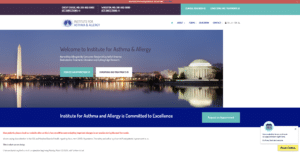
Key takeaways from this website:
- Easy to access appointment booking options
- Online contact forms and patient forms
- Links to Google Maps directions to their office locations
- Patient Portal from CureMD Corporation
- Interactive maps in the footer
2. Informative Website Content
If you want to take your allergist website to the next level, make it informative, and provide extensive content related to your services, such as allergy treatments. If your patients learn something, they are going to come back frequently. If they find the content on your site valuable, they will likely click through other pages to find more useful information. When patients find something on a site that answers their medical questions or matches their medical needs, the chances increase that they will schedule an appointment to learn more.
When you look at Neil Patel’s marketing statistics, you realize that content marketing is around 62 percent cheaper than going the traditional marketing route. However, it produces three times the leads. Sharing content on a site is a cost-effective way for you to get ahead of your fellow practitioners.
Keep your blogs and news alerts up-to-date. If you go many months without blogging or if the news information you have on your site is outdated, it could seem like you are not engaged with your website. It might seem like you are out of date and not connected to the allergist community.
As you go through the process of creating content for your visitors, remember that quality content improves brand awareness. Your content can attract more people to your site and may encourage patients to keep visiting your clinic. Reviews, Q&A’s, service pages, and blogging should be at the heart of your content marketing strategy.
Example: Allergy Partners
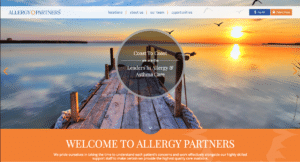
Key takeaways from this website:
- Consistent blog posts with relevant and informative content
- Dedicated pages for education, conditions, and treatments
- Video content featuring doctors and allergy specialists
3. Make Your Website Easy to Navigate
A well-designed allergist website has a navigational structure designed so that users can easily find their way around the website. The last thing you want is for visitors to get frustrated and navigate away.
A recent study showed that 94 percent of users see the ease of navigation as the most crucial web feature a new website can have. If your website is easy to navigate, it’s more effective. It shouldn’t be a challenge for patients to find their way around your website. If it’s a challenge, they are going to go somewhere else.
There are a few things that you can do when crafting your website to build with ease of navigation in mind.
- Create a Well-Designed Menu
Your patients or visitors to your site should be able to find the relevant information they need quickly. Your menu should highlight the essential pages using a hierarchical structure. Pages that take precedent should be on top. Do not forget to include a contact us page and a service page. Your titles should be clear and concise. Visitors to your site should have a clear understanding of what is on your site by looking at the menu on the landing page.
- Actionable Call to Action
The call of action is what motivates potential patients to walk into your office. You need your call to action to be clear, concise and provide direction.
Calls to actions should be placed strategically throughout your webpage. These should redirect users to top priority pages. Examples of these would include pages that allow your patients to book online appointments and use your patient portal.
Example: Bernstein Allergy Group

Key takeaways from this website:
- Clean and uncluttered design with an excellent navigation flow
- Complete main menu in the header with address and contact information
- Call to action buttons and link strategically placed throughout the site
4. Design with Mobile in Mind
If your website is not mobile-friendly, you are not using website best practices. People are on their phones all the time. If they get a sniffle, feel pain, or have a sense of unease, they are going to reach for their phone to look for answers to their health issues. If your website does not load well on their mobile phone, they are going to navigate away.
An allergist website that is mobile responsive should adjust to the size of a smartphone, tablet, or computer. Users should be able to interact with your website regardless of the device they are on. If a person is sick and has trouble reaching a doctor or finding information, they will have little patience for a website that does not have mobile responsiveness.
If your website is mobile-friendly, you improve the UX (user experience) for mobile visitors. You can also increase your visibility with search engines. Since 2015, Google has been using mobile-friendliness as a ranking signal.
Example: Allergy & ENT Associates
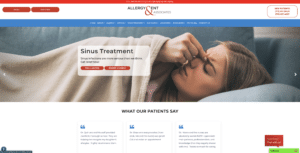
Key takeaways from this website:
- Website layout, images, and text automatically switches to accommodate a mobile view
- Provides easy access to contact information and forms
- Most important information is viewable without scrolling
5. Eye-Catching Images
If you want to take your website to the next level, include eye-catching imagery. People respond better to imagery than they do to pages that are full of heavy text.
On your allergist website, use high-quality photographs to show the services you provide. This will make it so that your prospective patients will see if your offerings match up with what they need.
Don’t forget to include photographs of your doctors. When patients see a doctor’s smiling face, they feel comfortable because they know who they are booking their appointment with. Also, include videos, slideshows, and audio to help humanize your site. By adding the human element to the service you provide, you increase the impact you have on visitors.
Let’s do a quick run-through of how you can improve the visual content on your website and make it stand out to visitors.
- Use images and videos. Use these as a way to highlight different aspects of your practice. Your images and videos should be high and should show your staff working. This will help your patients connect with your staff.
- Be strategic in your selection of photos and visual elements. Videos are a medium that can reach the minds and hearts of visitors to your site. However, too many images can be distracting. If the pictures you upload are not optimized or include too many, your page speed will suffer.
- Make your educational content more engaging and informative. Do this by including medical designs and images.
Example: Allergy Experts
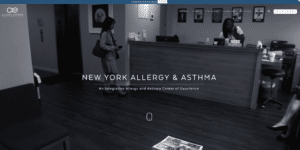
Key takeaways from this website:
- Homepage includes video loop showcasing office and staff
- Headshots of doctors
- Images are included with each blog post and service page
6. Include Contact Information
Visitors to your site should be able to see your contact information on every page. Place it in the top right corner and include it in the footer of each page. If done correctly, the information will not clutter your website. However, it will give your patients the relevant information they need.
Example: Premier Allergy and Asthma

Key takeaways from this website:
- Contact information remains in the header on each page
- Each location’s contact information is included in the footer
- Easy to use appointment request form
7. About Us Section
Having an about us section is a must. This is where you tell your story. This is where you tell your patients who you are and what you value. The information provided must be compelling, factual, and up-to-date. This is where you outline your goals and mission. Don’t be afraid to show awards, testimonials, and success stories.
Example: Kaufman Allergy
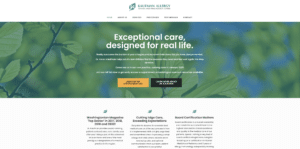
Key takeaways from this website:
- Provides an excellent doctor bio that includes accomplishments, experience, and background information
- About Us section puts focus on creating a personal connection with patients
8. Insurance and Services
Your visitors are going to be concerned about insurance. Patients need to be able to find the insurance providers you accept right away. You should also include any other payment arrangements you accept. Suggest that users call to see if a non-listed insurance is accepted.
Example: Allergy, Asthma, Immunology Care of Central Florida
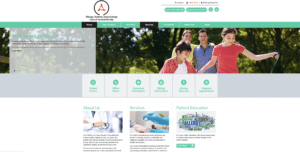
Key takeaways from this website:
- Easy access insurance and bill pay information (both displayed on the homepage)
- Provides a complete list of accepted insurance providers
9. Telemedicine
COVID-19 has changed what people want from medicine. You might lose patients if you don’t have options to schedule virtual appointments. If you are still seeing patients in the office, clearly lay out the protocols and safety procedures you are taking. Let your patients know what to expect from an in-person visit.
Example: Allergy and Asthma Associates
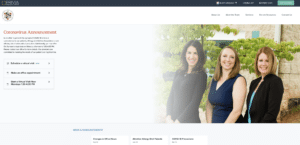
Key takeaways from this website:
- Options for virtual or in-office appointments are easily accessible on the homepage
- COVID-19 updates for the office is displayed on the homepage banner
- News and announcements for COVDI-19 precautions are provided on the homepage
Conclusion
There are several key elements to web design that will empower your website. Take the time to learn about each one and how they work together. Learn about color, design, photo galleries, and videos that can improve the end user’s experience.
It doesn’t matter what your medical focus is, you need to integrate several web design concepts in a way that is going to reach your clients and adequately represent your practice. If you do this correctly, you will build relationships with your patients and set the standard of service. They will think highly of you before they walk through your door.
Are you looking to improve your allergist website and increase website traffic? At NOVA MedMarket, our digital marketing experts can help you produce a high-quality and engaging Allergist website design optimized with SEO. Contact us today for more information.

